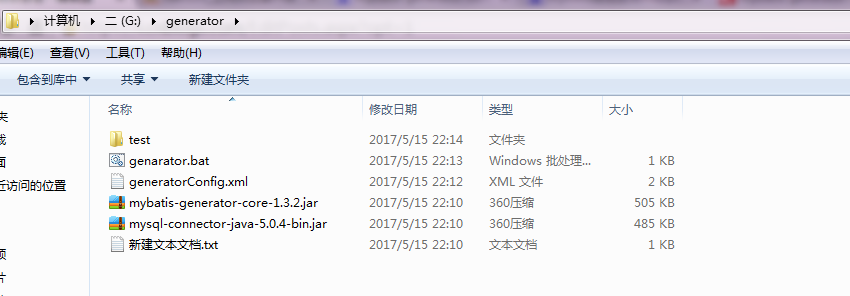Mybatis属于半自动ORM,在使用这个框架中,工作量最大的就是书写Mapping的映射文件,由于手动书写很容易出错,我们可以利用Mybatis-Generator来帮我们自动生成文件。
1、相关文件
1、在G盘新建一个文件夹,命名:generator(或者其他盘其他名字也可以,之所以用这个,是为了copy下面代码后,不用再做修改路径)
2、准备需要的jar包:mybatis-generator-core-1.3.2.jar、MySQL-connector-Java-5.1.34.jar(忽略版本号,这只是我用的jar 版本)
3、新建一个文件,命名:generatorConfig.xml
以下是相关文件截图:

和Hibernate逆向生成一样,这里也需要一个配置文件:
generatorConfig.xml
<?xml version="1.0" encoding="UTF-8"?>
<!DOCTYPE generatorConfiguration
PUBLIC "-//mybatis.org//DTD MyBatis Generator Configuration 1.0//EN"
"http://mybatis.org/dtd/mybatis-generator-config_1_0.dtd">
<generatorConfiguration>
<!--数据库驱动-->
<classPathEntry location="mysql-connector-java-5.0.4-bin.jar"/>
<context id="DB2Tables" targetRuntime="MyBatis3">
<commentGenerator>
<property name="suppressDate" value="true"/>
<property name="suppressAllComments" value="true"/>
</commentGenerator>
<!--数据库链接地址账号密码-->
<jdbcConnection driverClass="com.mysql.jdbc.Driver" connectionURL="jdbc:mysql://localhost/test" userId="root" password="123456">
</jdbcConnection>
<javaTypeResolver>
<property name="forceBigDecimals" value="false"/>
</javaTypeResolver>
<!--生成Model类存放位置-->
<javaModelGenerator targetPackage="model" targetProject="test">
<property name="enableSubPackages" value="true"/>
<property name="trimStrings" value="true"/>
</javaModelGenerator>
<!--生成映射文件存放位置-->
<sqlMapGenerator targetPackage="mapping" targetProject="test">
<property name="enableSubPackages" value="true"/>
</sqlMapGenerator>
<!--生成Dao类存放位置-->
<javaClientGenerator type="XMLMAPPER" targetPackage="dao" targetProject="test">
<property name="enableSubPackages" value="true"/>
</javaClientGenerator>
<!--生成对应表及类名-->
<table tableName="user" domainObjectName="User" enableCountByExample="false" enableUpdateByExample="false" enableDeleteByExample="false" enableSelectByExample="false" selectByExampleQueryId="false"></table>
</context>
</generatorConfiguration>
需要修改文件配置的地方我都已经把注释标注出来了,这里的相关路径(如数据库驱动包,生成对应的相关文件位置可以自定义)不能带有中文。
上面配置文件中的:
<table tableName="message" domainObjectName="Messgae" enableCountByExample="false" enableUpdateByExample="false" enableDeleteByExample="false" enableSelectByExample="false" selectByExampleQueryId="false"></table>
tableName和domainObjectName为必选项,分别代表数据库表名和生成的实体类名,其余的可以自定义去选择(一般情况下均为false)。
生成语句文件:
java -jar mybatis-generator-core-1.3.2.jar -configfile generatorConfig.xml -overwrite
2、使用方法
在该目录按住Shift键,右键鼠标选择"在此处打开命令窗口",复制粘贴生成语句的文件代码即可。
看下效果图:
首先这个是我的数据库表



生成相关代码:
User.java
package model;
public class User {
private Integer uid;
private String username;
private String password;
private String name;
private String email;
private String phone;
private String addr;
private Integer state;
private String code;
public Integer getUid() {
return uid;
}
public void setUid(Integer uid) {
this.uid = uid;
}
public String getUsername() {
return username;
}
public void setUsername(String username) {
this.username = username == null ? null : username.trim();
}
public String getPassword() {
return password;
}
public void setPassword(String password) {
this.password = password == null ? null : password.trim();
}
public String getName() {
return name;
}
public void setName(String name) {
this.name = name == null ? null : name.trim();
}
public String getEmail() {
return email;
}
public void setEmail(String email) {
this.email = email == null ? null : email.trim();
}
public String getPhone() {
return phone;
}
public void setPhone(String phone) {
this.phone = phone == null ? null : phone.trim();
}
public String getAddr() {
return addr;
}
public void setAddr(String addr) {
this.addr = addr == null ? null : addr.trim();
}
public Integer getState() {
return state;
}
public void setState(Integer state) {
this.state = state;
}
public String getCode() {
return code;
}
public void setCode(String code) {
this.code = code == null ? null : code.trim();
}
}
UserMapper.xml
<?xml version="1.0" encoding="UTF-8" ?>
<!DOCTYPE mapper PUBLIC "-//mybatis.org//DTD Mapper 3.0//EN" "http://mybatis.org/dtd/mybatis-3-mapper.dtd" >
<mapper namespace="dao.UserMapper" >
<resultMap id="BaseResultMap" type="model.User" >
<id column="uid" property="uid" jdbcType="INTEGER" />
<result column="username" property="username" jdbcType="VARCHAR" />
<result column="password" property="password" jdbcType="VARCHAR" />
<result column="name" property="name" jdbcType="VARCHAR" />
<result column="email" property="email" jdbcType="VARCHAR" />
<result column="phone" property="phone" jdbcType="VARCHAR" />
<result column="addr" property="addr" jdbcType="VARCHAR" />
<result column="state" property="state" jdbcType="INTEGER" />
<result column="code" property="code" jdbcType="VARCHAR" />
</resultMap>
<sql id="Base_Column_List" >
uid, username, password, name, email, phone, addr, state, code
</sql>
<select id="selectByPrimaryKey" resultMap="BaseResultMap" parameterType="java.lang.Integer" >
select
<include refid="Base_Column_List" />
from user
where uid = #{uid,jdbcType=INTEGER}
</select>
<delete id="deleteByPrimaryKey" parameterType="java.lang.Integer" >
delete from user
where uid = #{uid,jdbcType=INTEGER}
</delete>
<insert id="insert" parameterType="model.User" >
insert into user (uid, username, password,
name, email, phone,
addr, state, code)
values (#{uid,jdbcType=INTEGER}, #{username,jdbcType=VARCHAR}, #{password,jdbcType=VARCHAR},
#{name,jdbcType=VARCHAR}, #{email,jdbcType=VARCHAR}, #{phone,jdbcType=VARCHAR},
#{addr,jdbcType=VARCHAR}, #{state,jdbcType=INTEGER}, #{code,jdbcType=VARCHAR})
</insert>
<insert id="insertSelective" parameterType="model.User" >
insert into user
<trim prefix="(" suffix=")" suffixOverrides="," >
<if test="uid != null" >
uid,
</if>
<if test="username != null" >
username,
</if>
<if test="password != null" >
password,
</if>
<if test="name != null" >
name,
</if>
<if test="email != null" >
email,
</if>
<if test="phone != null" >
phone,
</if>
<if test="addr != null" >
addr,
</if>
<if test="state != null" >
state,
</if>
<if test="code != null" >
code,
</if>
</trim>
<trim prefix="values (" suffix=")" suffixOverrides="," >
<if test="uid != null" >
#{uid,jdbcType=INTEGER},
</if>
<if test="username != null" >
#{username,jdbcType=VARCHAR},
</if>
<if test="password != null" >
#{password,jdbcType=VARCHAR},
</if>
<if test="name != null" >
#{name,jdbcType=VARCHAR},
</if>
<if test="email != null" >
#{email,jdbcType=VARCHAR},
</if>
<if test="phone != null" >
#{phone,jdbcType=VARCHAR},
</if>
<if test="addr != null" >
#{addr,jdbcType=VARCHAR},
</if>
<if test="state != null" >
#{state,jdbcType=INTEGER},
</if>
<if test="code != null" >
#{code,jdbcType=VARCHAR},
</if>
</trim>
</insert>
<update id="updateByPrimaryKeySelective" parameterType="model.User" >
update user
<set >
<if test="username != null" >
username = #{username,jdbcType=VARCHAR},
</if>
<if test="password != null" >
password = #{password,jdbcType=VARCHAR},
</if>
<if test="name != null" >
name = #{name,jdbcType=VARCHAR},
</if>
<if test="email != null" >
email = #{email,jdbcType=VARCHAR},
</if>
<if test="phone != null" >
phone = #{phone,jdbcType=VARCHAR},
</if>
<if test="addr != null" >
addr = #{addr,jdbcType=VARCHAR},
</if>
<if test="state != null" >
state = #{state,jdbcType=INTEGER},
</if>
<if test="code != null" >
code = #{code,jdbcType=VARCHAR},
</if>
</set>
where uid = #{uid,jdbcType=INTEGER}
</update>
<update id="updateByPrimaryKey" parameterType="model.User" >
update user
set username = #{username,jdbcType=VARCHAR},
password = #{password,jdbcType=VARCHAR},
name = #{name,jdbcType=VARCHAR},
email = #{email,jdbcType=VARCHAR},
phone = #{phone,jdbcType=VARCHAR},
addr = #{addr,jdbcType=VARCHAR},
state = #{state,jdbcType=INTEGER},
code = #{code,jdbcType=VARCHAR}
where uid = #{uid,jdbcType=INTEGER}
</update>
</mapper>
UserMapper.java
package dao;
import model.User;
public interface UserMapper {
int deleteByPrimaryKey(Integer uid);
int insert(User record);
int insertSelective(User record);
User selectByPrimaryKey(Integer uid);
int updateByPrimaryKeySelective(User record);
int updateByPrimaryKey(User record);
}